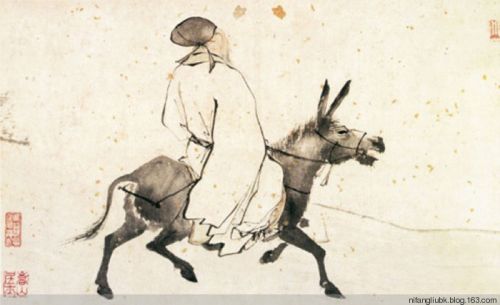 |
|
[www.haijiangzaixian.com]
|
To reach the destination, we first have to start. 千里之行始于足下 (qiān lǐ zhī xíng shǐ yú zú xià), a journey of a thousand miles begins with a single step. When we travel we say 上路 (shàng lù), hit the road. At the first 十字路口 (shí zì lù kǒu), crossroads, let’s head for 首都 (shǒu dū), the capital city. Beijng is also nicknamed 首堵 (shǒu dǔ), most congested, thanks to a pun on 首 (shǒu), first, and 堵 (dǔ), congestion.
We use 人来人往 (rén lái rén wǎng), passengers come and go, and 车水马龙 (chē shuǐ mǎ lóng), endless stream of horses and carriages, to describe the spectacle of snarled traffic in a city.
There are many ways to get into the city. The old-fashioned way is by 走路 (zǒu lù), walking, which can also be expressed as 步行 (bù xíng). 步 (bù) is foot, and 行 (xíng) is walk. But you can also choose to take a 车 (chē), vehicle. In the land of bicycles, you can also 骑自行车 (qí zì xíng chē), ride a bike. To put it more literally, 自行车 (zì xíng chē) is “a vehicle powered by yourself.” These are now replaced by电动车 (diàn dòng chē), electric bikes.
For anything we climb on, we use the verb 骑 (qí), ride, where the character for 马 (mǎ), horse, explains the origin of the word.
For vehicles where we sit, we use the verbs 坐 (zuò) or 乘 (chéng), which can be combined in the phrase 乘坐 (chéng zuò). This is the case for 火车 (huǒ chē), train, or more literally, “the vehicle that runs on fire, 汽车 (qì chē), automobile, or “the vehicle that runs on petrol,” and 飞机 (fēi jī), airplane, or “the flying machine.”
If you don’t have your own 私人轿车 (sī rén jiào chē), private car, or 司机 (sī jī), chauffeur, you can always get around by 出租车 (chū zū chē) or 计程车 (jì chéng chē), taxi. The first term signifies a “car for hire”; the second, “metered cars.” Interestingly, when you take a taxi you can say 打车 (dǎ chē), “hit a taxi,” or 打的 (dǎ dī), which origins from Cantonese dialect. The particle 打 (dǎ), used in many Chinese expressions, doesn’t really mean “to hit.” I assure you that the Chinese are not violent!
Otherwise, there’s still the option of 公共交通 (gōng gòng jiāo tōng), public transportation – 公交车 (gōng jiāo chē), bus, an abbreviation for “public transportation vehicle,” and 地铁 (dì tiě), metro, or the “underground railway.”
But back to the business of roads. There are many ways to talk about 路 (lù), road, in Chinese, according to the size. 马路 (mǎ lù), literally “horse road,” is a general term for any paved road. When we wander aimlessly down the street, we are 压马路 (yā mǎ lù), “rolling the road.” 大马路 (dà mǎ lù), boulevard, and 街道 (jiē dào), street, are used for urban roads, and 道路 (dào lù), path, has a more philosophical meaning.
When you 过马路 (guò mǎ lù), cross the road, you can choose to 走人行横道 (zǒu rén xíng héng dào), take a pedestrian crossing, 走天桥 (zǒu tiān qiáo), walk over an overpass, or 走地下通道 (zǒu dì xià tōng dào), use an underground crossing.
In Beijing’s 胡同 (hútòng), alleyways, you discover the charm of the peaceful neighborhoods along 小巷 (xiǎo xiàng), narrow passages, off-limits to cars. On the mountains, the steep narrow paths are likened to the twists and turns of a sheep’s insides – 羊肠小道 (yáng cháng xiǎo dào). And then there is China’s most famous route, 丝绸之路 (sī chóu zhī lù), the Silk Road.
But, don’t rush yet, because 欲速则不达 (yù sù zé bù dá), haste makes waste, and you risk 走投无路 (zǒu tóu wú lù) getting stuck in a dead end. With patience, you await an easier path, 一路平安 (yí lù píng ān), have a safe trip!
We Recommend:
